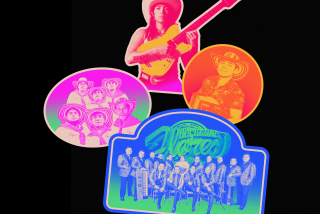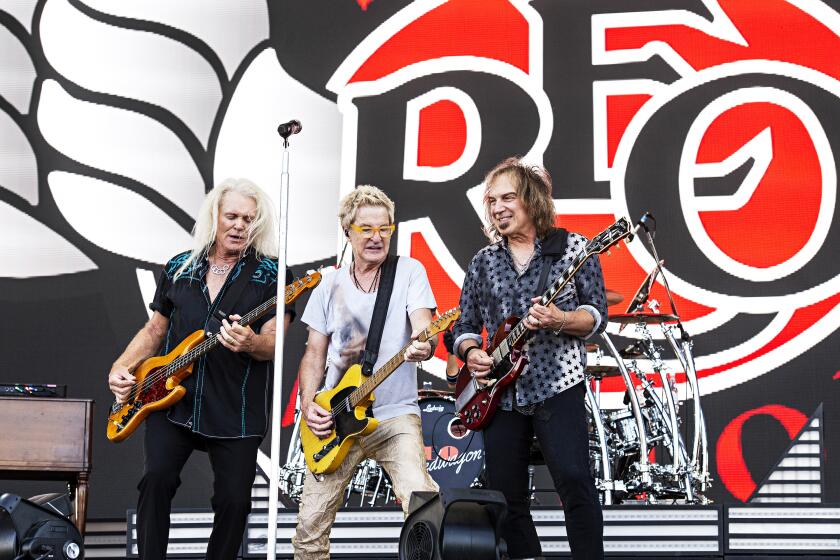Mongo Santamaria, 80; Percussionist, Bandleader in Forefront of Latin Jazz
Mongo Santamaria, the pioneering Cuban percussionist who was among the most acclaimed exponents of Latin jazz and whose 1963 Top 10 hit “Watermelon Man” stands as a precursor of pop crossover in Latin music, died Saturday at a hospital in the Miami area, where he had retired.
The conga player, who was 80, had been on life support after suffering a recent stroke.
“His band was like a school for so many musicians who passed through it,” his son, Jose “Monguito” Santamaria, said Monday.
The elder Santamaria, the Havana-born grandson of a former slave, spent more than half a century exploring the nexus between the polyrhythmic music of his native country and various forms of American popular music, especially jazz, funk and R&B.;
In a remarkably enduring career, he worked with leading figures from both worlds, including trumpeter Dizzy Gillespie, vibraphonist Cal Tjader, and fellow drummers and bandleaders Tito Puente and Perez Prado.
Santamaria’s bands, which included such jazz musicians as Chick Corea and Hubert Laws, “were in large part responsible for the gradual absorption of Latin rhythms into black music,” states the New Grove Dictionary of Jazz.
Though once admitting he had allowed record label pressures to define his repertoire on some of his scores of albums, Santamaria remained true to the genuine spirit of Afro-Cuban drumming, including its religious roots. His style, studied for its simultaneous power and lyricism, influenced a generation of percussionists, including Los Angeles-based bandleader Poncho Sanchez.
Santamaria’s melodic approach has been overshadowed by contemporary congueros who stress lightning-fast techniques, said jazz radio host Jose Rizo. “But that’s only a fad, because Mongo never played that quick, and he’s the greatest,” said Rizo, host of the weekly “Jazz on the Latin Side” on KKJZ-FM (88.1). “He had a way of providing the proper accents behind jazz harmonies, and that was his real touch.”
Born Ramon Santamaria in 1922, he was raised in a poor Havana neighborhood rich in Afro-Cuban traditions. His mother wanted him to play violin, but the drum held an early allure. He dropped out of school in his teens to become a professional musician, working as a mailman by day and playing at the famed Tropicana club at night.
As a member of Havana’s Casino de la Playa, he rubbed shoulders with a flamboyant fellow percussionist named Perez Prado, who would soon spark the mambo craze of the 1950s. Santamaria joined Prado’s band in Mexico City in the late 1940s, then made the big jump to New York, where he debuted with Prado’s band in 1950.
Santamaria settled in the U.S. at a time when jazz and Latin musicians were increasingly joining forces. He played with the Tito Puente Orchestra during its 1950s heyday, and was featured on “Puente in Percussion” -- an album that is still considered a classic of the genre -- with a rhythm section that also featured Willie Bobo and Carlos “Patato” Valdes.
After a falling out with Puente, Santamaria and Bobo moved to California to join a jazz band led by vibraphonist Tjader, who recorded for the Berkeley-based Fantasy label. Tjader’s legendary percussion section helped spawn the cool West Coast school of Latin jazz.
In 1958, Santamaria started making his own recordings as a bandleader for Fantasy, starting with “Yambu” and “Mongo,” later reissued as a two-record set titled “Afro Roots.” He made a mark from the start with his composition “Afro Blue,” which became a jazz standard, covered most famously by John Coltrane.
Though Santamaria never had another hit like “Watermelon Man” (which was written by Herbie Hancock), he enjoyed a resurgence of popularity among Latin fans during the salsa boom of the 1970s, when he recorded under the famed Fania Records umbrella. In 1977, Santamaria’s “Chango,” his 1955 classic of Afro-Cuban ritual drumming, was reissued by Fania on its Vaya label as “Drums and Chants.” That same year, he brought the first Grammy to Fania for “Dawn,” honored as best Latin recording.
In a sign of his enduring legacy, 14 catalog albums by Santamaria are still available from Fantasy.
Next month, the label plans to release another, “Montreux Heat,” which features previously unreleased cuts from a 1980 concert, including an extended version of “Watermelon Man,” featuring Gillespie and Toots Thielemans.
In his quiet retirement, Santamaria spent his days immersed in his three passions: baseball, politics and music.
He had a large record collection that included old 78 rpm discs, but kept current with the new music coming from his homeland, listening to bands such as Irakere and Manolito y su Trabuco.
Santamaria’s greatest satisfaction, his son said Monday, was knowing that he had nurtured many musicians in his band.
“I’m not a hero,” Santamaria told Down Beat magazine in 1999, “but I did my best to make everybody happy.”
He was buried Monday at Woodlawn Park South Cemetery in Kendall, Fla., where he lived. The service featured the reading of poetry and the playing of a rumba at his graveside by fellow percussionist Daniel Ponce and other musicians.
In addition to his son Monguito, who briefly pursued his own recording career in the 1970s, Santamaria is survived by five other children, Nancy Anderson, Rosa Santamaria and Felipe Santamaria, all of Miami; Felicia Santamaria of Los Angeles; and Ileana Santamaria of New York City; two sisters, Alicia Valdez of Miami and Rosa Mendiola of New York; nine grandchildren; and two great-grandchildren.
More to Read
The biggest entertainment stories
Get our big stories about Hollywood, film, television, music, arts, culture and more right in your inbox as soon as they publish.
You may occasionally receive promotional content from the Los Angeles Times.










